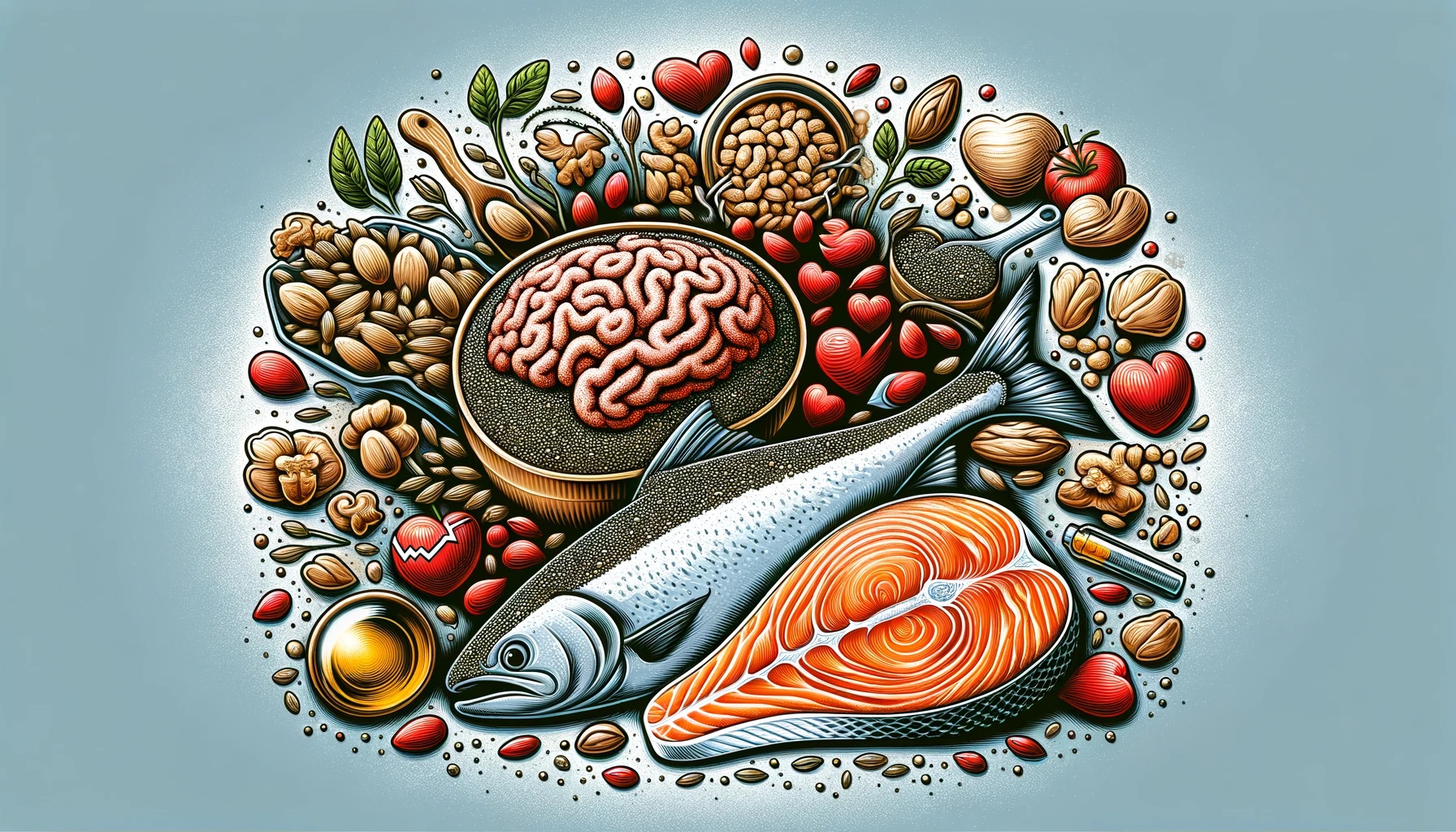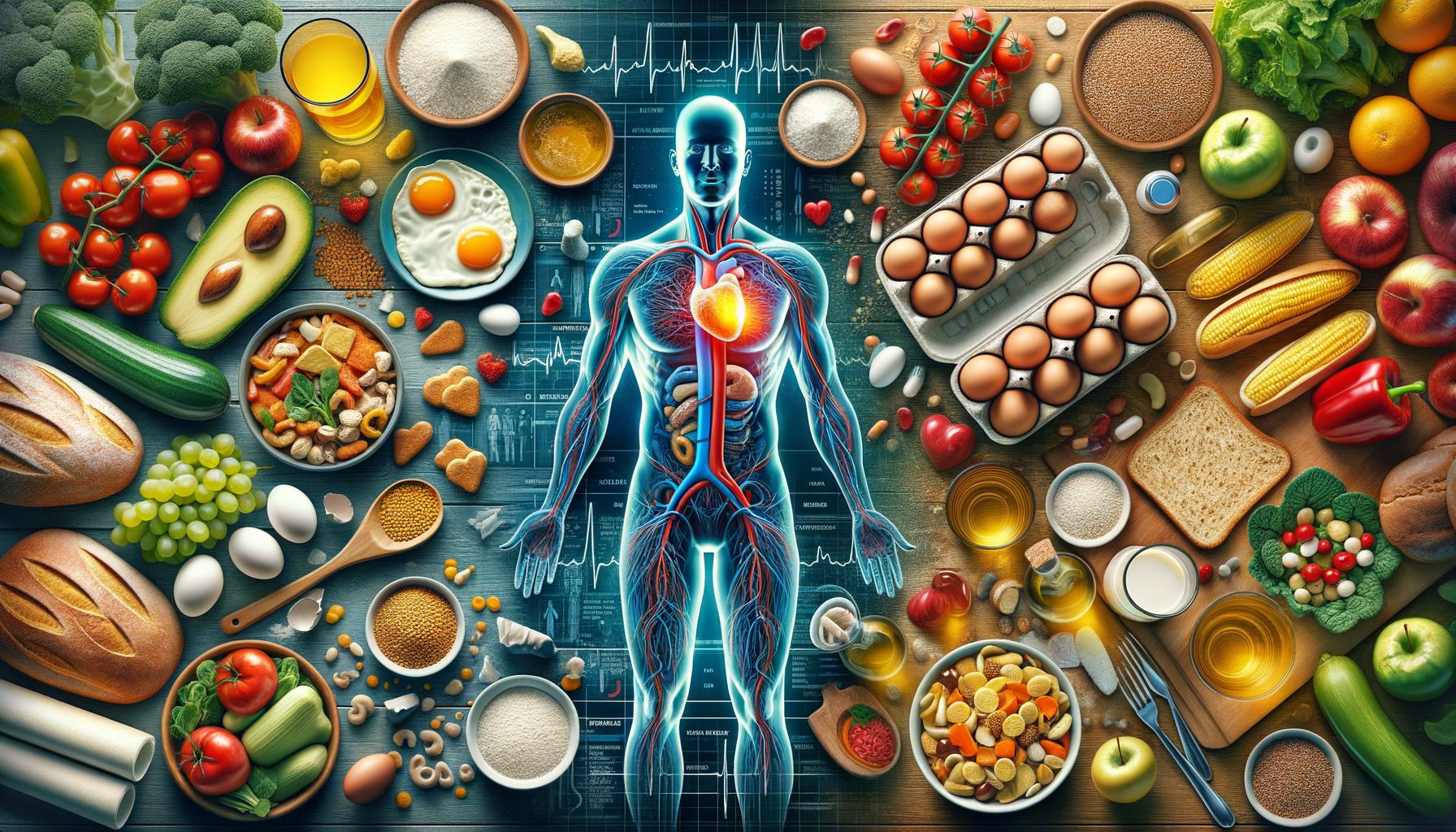· nutrition · 18 min read
Quinoa: The Super Seed Packed with Nutrients
Dive deep into the world of Quinoa, a super seed that offers a multitude of health benefits. Discover its nutritional profile, how it supports your health, and delicious ways to incorporate it into your diet.

In This Post
The Fact Why Should I Care How To Put In Action Start Tomorrow Guide How does it effect my ability to focus How does it impact my daily life How does it help me make friends How does it help me manage stress How does it effect my mood Summary: Remember Refresher Checklist The Full Research Article CitationsPrint Out The Tomorrow Checklist!
Sign up for our newsletter and receive a copy today, so that, you can start tomorrow! Or the next day, or the day after that. I forget everything and starting things is hard at least for me so these checklists are godsend.
Print Out The Remember Refresher Checklist!
Sign up for our newsletter and download your own copy of the Remember Refresher Checklist, so that, you can easily put it on your fridge and help you stay on target towards your WHY. Every little bit helps.
Introduction
Quinoa: More Than Just a Supergrain
Quinoa, often hailed as a supergrain, transcends this simplistic description in numerous ways. It’s not only a versatile ingredient in the culinary world but also a nutritional powerhouse that caters to a broad spectrum of dietary needs. Quinoa holds a prestigious place as a dietary staple, especially among those who prioritize plant-based nutrition. Its remarkable ability to provide a complete protein profile, which is rare in plant foods, makes it an indispensable part of vegetarian and vegan diets.
The allure of quinoa lies not just in its health benefits but also in its adaptability in various dishes, from salads to main courses. Its grain-like texture and nutty flavor enhance any meal, making it a beloved supergrain among health enthusiasts and food lovers alike. Yet, its classification as a grain is a common misconception, as quinoa is technically a seed. This unique characteristic contributes to its gluten-free nature, allowing even those with gluten sensitivities to enjoy this nutritious seed.
Overview of Quinoa’s Nutritional Profile
Quinoa’s nutritional profile is impressively comprehensive, boasting a multitude of vitamins, minerals, and other health-promoting compounds:
- Complete Protein: Quinoa contains all nine essential amino acids, making it a complete protein source. This is particularly beneficial for individuals following a plant-based diet.
- Fiber-Rich: High in dietary fiber, quinoa supports digestive health and may aid in weight management.
- Mineral Content: It’s a rich source of minerals such as iron, magnesium, and manganese, which are vital for various bodily functions.
- Antioxidants: Quinoa is loaded with antioxidants that help reduce inflammation and protect the body’s cells.
- Low Glycemic Index: Its low glycemic index makes it a safe choice for maintaining stable blood sugar levels.
Quinoa’s versatility as both a health supplement and a culinary ingredient cannot be overstated. Whether you’re looking to enhance your health or simply want a delicious, nutrient-dense option for your meals, quinoa stands out as an excellent choice.
Checklist for Incorporating Quinoa into Your Diet:
- Try quinoa as a base for salads and bowls.
- Use it as a substitute for rice or pasta.
- Experiment with quinoa in baked goods for a protein boost.
- Add it to soups and stews for extra texture and nutrients.
- Enjoy quinoa as a breakfast cereal, cooked with your favorite milk and toppings.
Embracing quinoa as part of your diet promises not just a variety of delicious culinary experiences but also a significant boost to your overall health, thanks to its supergrain qualities.
The Origin and Nature of Quinoa
Quinoa has intrigued nutritionists, health enthusiasts, and environmentalists alike, but to truly appreciate its value, it’s essential to delve into its rich history, clarify common misconceptions, and understand its botanical family ties.
The Historical Significance of Quinoa
Quinoa is often hailed as an “ancient grain,” having been a dietary staple for thousands of years in South America. It was cultivated by the Incas who considered it the “mother of all grains” and believed it to be sacred. Quinoa played a crucial role in their culture, not just as a food source but also in their rituals. However, its significance extends beyond historical curiosity. This sustainability of quinoa as a crop, even in harsh and varied climates, speaks to its potential as a sustainable crop in today’s world grappling with climate change.
Why Quinoa is Misunderstood as a Grain
There is a common misconception that categorizes quinoa as a grain. This confusion stems primarily from its grain-like preparation and use in meals. However, quinoa is, in fact, a seed from the Chenopodium quinoa plant. What differentiates it from traditional grains is how it’s consumed and processed. Grains are the seeds of grasses, whereas quinoa grows from a plant that thrives even in non-arable conditions, making it not only a superfood in terms of nutrition but also in its adaptability.
The Botanical Family of Quinoa: A Relation to Spinach and Beets
One might find it surprising that quinoa is a relative of spinach and beets. They all belong to the Amaranthaceae family, known for its healthful and versatile species. This relation explains why the plant parts of quinoa, aside from the seed, are also nutritious and edible. Understanding this family connection helps us appreciate quinoa’s unique nutritional profile, which is enriched by the phytonutrients common to this botanical group.
Understanding Quinoa’s Botanical Roots: A Checklist
- Quinoa is not a grain but a seed.
- It belongs to the Amaranthaceae family, akin to spinach and beets.
- The entire quinoa plant is nutritious and consumable.
- Quinoa’s versatility as a crop supports its status as a sustainable and adaptable food source.
Quinoa’s story is one of resilience, adaptability, and ancient reverence. Its mistaken identity as a grain only scratches the surface of its profound nature. By tracing its origins and understanding its place in the botanical world, one gains a deeper appreciation for quinoa. This super seed’s historical data underscores its potential as a resilient, nutrient-dense, and sustainable crop, not just for today’s health-conscious consumers but also as a solution for future agricultural challenges.
The Nutritional Powerhouse
Quinoa has been lauded as a supergrain, but its value extends far beyond being just another health food trend. Understanding the nutritional composition of quinoa can illuminate why it’s seen as such a vital component of diets, especially for those following plant-based nutrition plans.
Understanding Complete Proteins: Quinoa’s Amino Acid Profile
Proteins are made up of amino acids, some of which are termed “essential” because our bodies cannot produce them. They must be obtained from our diet. Most plant-based foods lack one or more essential amino acids, making it challenging to get complete proteins from a vegetarian or vegan diet. This is where quinoa stands out.
Quinoa is a rare plant-based food that contains all nine essential amino acids, making it a complete protein. This quality is particularly beneficial for those who do not consume animal products. The amino acids in quinoa include lysine, which is vital for tissue growth and repair, and isoleucine, important for immune function, hemoglobin production, and energy regulation.
The Importance of Fiber: How Quinoa Contributes to Digestive Health
Quinoa’s benefits extend into the realm of digestive health, thanks to its high fiber content. A single serving of quinoa can provide:
- A significant portion of the daily recommended intake of fiber.
- Help in the prevention of constipation.
- Promotion of regular bowel movements.
Incorporating quinoa into meals can be a simple yet effective way to maintain a healthy digestive system.
Iron, Magnesium, and Manganese: Quinoa’s Mineral Richness
Quinoa is not just rich in vitamins but is also packed with minerals that play crucial roles in our body. Let’s breakdown some of the significant minerals found in quinoa:
- Iron: Essential for the formation of red blood cells and transportation of oxygen throughout the body.
- Magnesium: Key for muscle function, nerve function, and maintaining a healthy heartbeat.
- Manganese: Plays a role in bone formation, blood clotting, and reducing inflammation.
These minerals contribute to quinoa’s status as a nutritional powerhouse, providing essential nutrients that support overall health.
Quinoa for Vegans and Vegetarians: A Vital Protein Source
For those following a vegan or vegetarian lifestyle, getting enough protein can sometimes be a challenge. Quinoa offers a solution as a versatile and protein-rich food that can easily be incorporated into various meals. Here’s a checklist for incorporating quinoa into a plant-based diet:
- Use quinoa as a base for salads or bowls.
- Mix quinoa into soups or stews for added texture and nutrients.
- Create quinoa patties as a protein-rich alternative to meat.
- Use quinoa flour in baking to increase the protein content of your baked goods.
Quinoa provides a simple yet effective way for vegans and vegetarians to ensure they are getting a sufficient amount of complete protein in their diets, alongside a broad spectrum of essential vitamins and minerals. This supergrain lives up to its name, offering a multitude of health benefits and proving itself as a cornerstone in the realm of nutritional, plant-based eating.
The Health Benefits of Quinoa
Quinoa, often hailed as a supergrain, is more than just a popular dietary staple among vegetarians and vegans; it’s a nutrient-dense powerhouse that offers a multitude of health benefits. With its high fiber content, impressive mineral content, and low glycemic index, quinoa can significantly contribute to improving overall well-being. Here, we explore how quinoa positively impacts heart health, strengthens bones and muscles, manages blood sugar and weight, and reduces inflammation.
Boosting Heart Health with Quinoa’s Fiber Content
Heart disease remains a leading cause of death worldwide, but diet plays a crucial role in heart health. Quinoa, with its high fiber content, is an exceptional choice for those looking to support a healthy heart. Dietary fiber helps to lower levels of bad cholesterol (LDL) and total cholesterol, decreasing the risk of developing heart disease. Additionally, the fiber in quinoa helps in maintaining healthy blood pressure levels.
- Include quinoa in your daily diet to boost fiber intake.
- Replace refined grains with quinoa to manage cholesterol levels.
Strengthening Bones and Muscles with Magnesium
Magnesium is vital for bone health as it assists in the development of bone structure and the synthesis of bone matrix. Quinoa’s rich magnesium content not only supports bone health but also plays a crucial role in muscle function, including that of the heart muscle. Regular consumption of magnesium-rich foods like quinoa can prevent magnesium deficiency, which is linked to osteoporosis, muscle weakness, and cramps.
- Consume quinoa regularly to meet the daily magnesium requirement.
- Incorporate other magnesium-rich foods alongside quinoa for optimal bone and muscle health.
Managing Blood Sugar and Weight with Quinoa’s Low Glycemic Index
For individuals managing diabetes or looking to maintain a healthy weight, quinoa is an excellent dietary choice. Its low glycemic index means that it has a minimal impact on blood sugar levels, preventing spikes that can lead to insulin resistance over time. Additionally, the fiber and protein in quinoa contribute to a feeling of fullness, aiding in weight management by reducing overall calorie intake.
- Choose quinoa as a complex carbohydrate source over high glycemic index options.
- Use quinoa in meals to prolong satiety and prevent overeating.
Quinoa’s Role in Reducing Inflammation and Promoting Overall Well-being
Chronic inflammation is associated with a range of health issues, including heart disease, diabetes, and cancer. Quinoa is rich in anti-inflammatory phytonutrients and antioxidants, which help to combat oxidative stress and reduce inflammation. Including quinoa in your diet can assist in promoting overall well-being and preventing chronic diseases.
- Incorporate quinoa into your diet to take advantage of its anti-inflammatory properties.
- Pair quinoa with other antioxidant-rich foods to enhance its inflammation-reducing effects.
Quinoa, with its wide array of health benefits, is a true nutritional powerhouse. From supporting heart health to reducing inflammation, the positive impacts of incorporating quinoa into your diet are substantial. Whether you’re looking to improve bone strength, manage your weight, or simply maintain overall well-being, quinoa offers a versatile, nutrient-packed option that complements any healthy eating plan.
Incorporating Quinoa into Your Diet
Incorporating quinoa into your diet can seem challenging at first, but its versatility can make it a staple in your meals in no time. Quinoa is not only a nutrient-dense ancient grain but also a culinary chameleon, fitting seamlessly into a wide array of recipes. From breakfast bowls to hearty dinners, quinoa’s subtle, nutty flavor and satisfying texture can enhance any meal. Here’s how you can make this supergrain a regular part of your diet.
Easy and Delicious Quinoa Recipes
Quinoa can be the star of the dish or a complementary side; its adaptability is one of its greatest strengths. Begin with simple recipes like quinoa salads tossed with your favorite vegetables and a zesty dressing or quinoa bowls topped with sautéed greens, roasted chickpeas, and a drizzle of tahini. For breakfast, substitute your usual oatmeal with quinoa porridge, sweetened with a touch of maple syrup and fresh berries. As you become more familiar with quinoa, explore incorporating it into soups, stews, and even baking recipes for an extra dose of protein.
How to Properly Cook and Store Quinoa
To ensure your quinoa is fluffy and delicious, proper cooking is key. Start by rinsing the quinoa under cold water to remove its natural coating, saponin, which can give it a bitter taste. Use a fine-mesh sieve for this step. Cook quinoa in water or broth using a 2:1 ratio, meaning two cups of liquid for every cup of quinoa. Bring it to a boil, then reduce the heat, cover, and simmer for about 15 minutes or until the quinoa has absorbed all the liquid. Allow it to sit covered for 5 minutes after cooking, then fluff with a fork before serving.
Store cooked quinoa in an airtight container in the refrigerator for up to a week, or freeze it for longer storage. This makes it easy to have quinoa on hand for quick meals throughout the week.
Quinoa Varieties and Their Unique Traits
Quinoa comes in several varieties, each bringing its unique characteristics to dishes. The most common types include:
- White quinoa: The most widely available, it has the mildest flavor and cooks up the fluffiest.
- Red quinoa: Holds its shape better than white quinoa, making it perfect for cold salads.
- Black quinoa: Has a slightly earthier and sweeter taste, with a crunchier texture.
Experimenting with different types will introduce you to the range of flavors and textures quinoa has to offer.
Creative Ways to Add Quinoa to Your Meal Plan
Incorporating quinoa into your diet doesn’t have to be complicated. Here are some creative, straightforward ways to start:
- Breakfasts: Mix cooked quinoa into your morning yogurt or smoothie bowls for an extra protein boost.
- Lunches: Prepare stuffed bell peppers or tomatoes with a filling of quinoa, beans, and spices for a satisfying, fiber-rich lunch.
- Snacks: Bake quinoa energy bars or balls combining quinoa with nuts, dried fruits, and honey for an on-the-go snack.
- Dinners: Use quinoa as a base for stir-fries or as a stuffing for roasted vegetables.
Checklist to Incorporate Quinoa into Your Diet:
- Start with simple quinoa recipes and gradually explore more complex dishes.
- Always rinse quinoa before cooking to remove the bitter saponin coating.
- Experiment with different quinoa varieties to enjoy a range of flavors and textures.
- Prepare quinoa in batches for easy meal planning throughout the week.
- Get creative by including quinoa in breakfast, lunch, snacks, and dinner.
Incorporating quinoa into your diet is an excellent way to boost your intake of proteins, minerals, and fiber, contributing to overall health and wellness. With its versatility and nutrient profile, quinoa can easily become a dietary staple, offering benefits that cater to everyone, from vegans and vegetarians to those simply seeking a healthier, plant-based nutrition option.
FAQs
Is Quinoa Gluten-Free?
Quinoa is a dream come true for those following a gluten-free diet. It’s completely gluten-free and a fantastic alternative to gluten-containing grains. Quinoa is not only a safe choice for people with celiac disease or gluten sensitivity but also packs a nutritional punch, making it a superior option for anyone looking to enrich their diet. It’s a whole grain (technically a seed) that ensures you don’t miss out on essential nutrients while avoiding gluten. Integrating quinoa into your meals contributes to a balanced, nutrient-dense diet without the worry of gluten.
How Does Quinoa Compare to Other Grains in Terms of Protein Content?
When it comes to protein, quinoa stands out among grains and seeds. It’s a complete protein, which means it provides all nine essential amino acids that our bodies can’t make on their own. Here’s a quick comparison:
- Quinoa: Approximately 8 grams of protein per 1 cup cooked.
- Brown Rice: About 5 grams of protein per 1 cup cooked.
- Wheat: Roughly 6-7 grams of protein per 1 cup cooked.
Quinoa surpasses many commonly consumed grains in protein content, making it an excellent choice for vegetarians, vegans, and anyone looking to increase their plant-based protein intake.
Can Quinoa be Considered a Good Source of Antioxidants?
Absolutely! Quinoa is rich in antioxidants, which are compounds that fight off free radicals in your body, lowering the risk of chronic diseases and inflammation. It contains quercetin and kaempferol, two powerful plant antioxidants with numerous health benefits. Including quinoa in your diet can contribute to your overall antioxidant intake, helping to reduce inflammation and protect your cells.
What Are Some Common Allergies and Sensitivities Related to Quinoa?
While quinoa is generally safe and beneficial for most people, a small percentage may experience allergies or sensitivities. Here’s a quick checklist of symptoms to watch for:
- Digestive discomfort such as bloating or diarrhea
- Nausea or vomiting
- Itchy skin or rash
- Difficulty breathing in severe cases
If you notice any of these symptoms after consuming quinoa, it’s best to consult a medical professional. While rare, quinoa allergies are possible and may be due to the saponins on the seed’s outer layer, which can be minimized by thoroughly rinsing quinoa before cooking.
Quinoa is not only a highly nutritious and versatile ingredient but also caters to a wide range of dietary needs, including gluten-free, vegetarian, and vegan diets. Its high protein content compared to other grains makes it a valuable protein source. Furthermore, its antioxidant properties contribute to a healthy diet, promoting well-being. However, it’s important to be mindful of potential sensitivities and consult health professionals if any adverse reactions occur.
Conclusion: Summarizing the Super Seed Benefits of Quinoa
Quinoa, often celebrated as a supergrain, stands as a nutritional powerhouse in the realm of plant-based nutrition. With its unique qualities and extensive benefits, it has rightly earned its place as a staple in healthy diets around the world. As we conclude our deep dive into the wonders of quinoa, let’s take a moment to encapsulate its paramount benefits and reaffirm why this ancient seed is more than just a dietary trend.
Key Takeaways of Quinoa’s Super Seed Benefits
Complete Protein Source: Quinoa is one of the few plant foods that offer a complete protein profile, containing all nine essential amino acids necessary for human health. This makes it an invaluable protein source, especially for vegetarians and vegans.
Fiber-Rich: With a high fiber content, quinoa aids in maintaining digestive health, preventing constipation, and contributing to a feeling of fullness, which can aid in weight management.
Rich in Minerals and Vitamins: Packed with minerals like iron, magnesium, and manganese, quinoa supports bone health, muscular function, and overall energy levels. Its vitamin content, including B vitamins, contributes to overall well-being.
Gluten-Free: Quinoa is a fantastic gluten-free option that can be enjoyed by those with celiac disease or gluten sensitivities, providing a safe yet nutrient-dense food choice.
Low Glycemic Index: Its low glycemic index makes quinoa an excellent food for blood sugar management, beneficial for those with diabetes or anyone looking to maintain balanced energy levels throughout the day.
Anti-Inflammatory and Antioxidant Properties: With a range of phytonutrients, quinoa supports the body’s ability to reduce inflammation and combat oxidative stress, promoting long-term health and reducing the risk of chronic disease.
Culinary Versatility: Quinoa’s versatility in cooking and its ability to absorb flavors makes it an easy and delicious addition to any meal, from breakfast porridges to salads, main dishes, and even desserts.
Checklist for Incorporating Quinoa into Your Diet
- Try replacing rice with quinoa in your next meal to add a protein boost.
- Experiment with different quinoa varieties (white, red, black) to enjoy its diverse flavors.
- Add quinoa to your breakfast by mixing it into yogurts or smoothies for an energy-boosting start.
- Use quinoa as a base for salads packed with vegetables for a filling and nutritious lunch.
- Explore quinoa recipes online to discover creative ways to incorporate this ancient grain into your diet.
Quinoa’s remarkable nutrient profile and its myriad health benefits—ranging from heart health and weight management to fostering plant-based, sustainable diets—emphasize its role as a super seed. Its status as a complete protein, combined with its gluten-free nature and essential nutritional content, underscores the importance of including quinoa in a balanced diet. Whether you are a long-time fan or a newcomer to this nutrient-dense seed, quinoa’s versatile and health-promoting qualities make it an indispensable part of healthy eating.
Relevant External Links
In the journey of exploring the multifaceted benefits of quinoa, we’ve touched upon its nutritional profile, health benefits, and versatile uses in everyday meals. To help you delve deeper into understanding quinoa’s outstanding qualities and how to incorporate this supergrain into your diet effectively, we recommend the following external resources that are rich in information and insights.
Quinoa: Profiles and Health Benefits
The Whole Grains Council provides a thorough exploration of quinoa through detailed profiles, discussing its health benefits extensively. Whether you’re a nutrition enthusiast or someone looking to make healthier dietary choices, this resource is invaluable. It not only celebrates quinoa as a nutrient-dense food but also promotes the broader consumption of whole grains for a balanced diet.
Quinoa Nutritional Facts
For those curious about the detailed nutritional breakdown of quinoa, NutritionData offers an extensive database of food nutritional facts, including those for quinoa. Understanding the nutritional content can aid in meal planning, especially for those adhering to specific dietary requirements such as high fiber, protein, or gluten-free diets.
Including Quinoa in a Balanced Diet
Lastly, Harvard Health Publishing provides expert advice on incorporating quinoa into a balanced diet. This resource, coming from a reputable health and nutrition authority, offers practical tips and insights into creating a well-rounded diet that supports overall health. It particularly emphasizes the role of foods like quinoa in enhancing dietary diversity and nutritional intake.
Further Exploration Checklist
To fully harness the nutritional powerhouse that is quinoa, consider the following steps:
- Visit the Whole Grains Council website to learn about the broader spectrum of whole grains and their health benefits.
- Check out NutritionData for a complete understanding of quinoa’s nutritional facts and how it compares with other grains and seeds.
- Read through the Harvard Health Publishing resources for expert advice on including quinoa and other nutritious foods in your diet effectively.
- Experiment with different quinoa recipes to keep your meals exciting and varied.
- Share your knowledge and experiences with quinoa with friends and family, promoting a healthier, plant-based nutrition lifestyle.
Through these actions, not only will you enrich your diet with this ancient grain’s incredible nutritional benefits, but you’ll also inspire those around you to consider more healthful, sustainable food choices. Quinoa’s versatility, combined with its rich mineral content, protein quality, and dietary fiber, makes it an outstanding component of any diet focused on wellness and preventive health.





